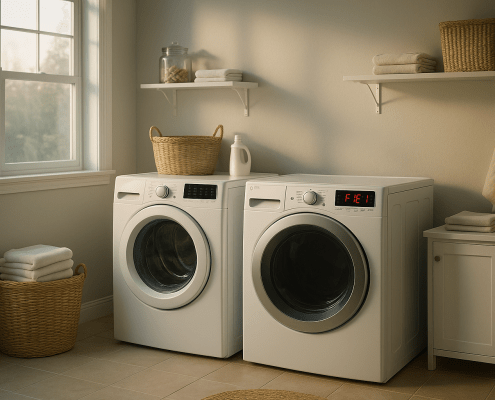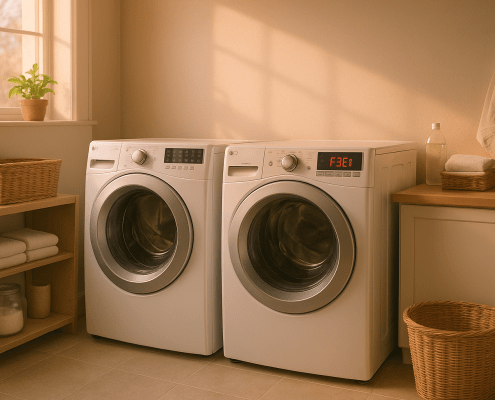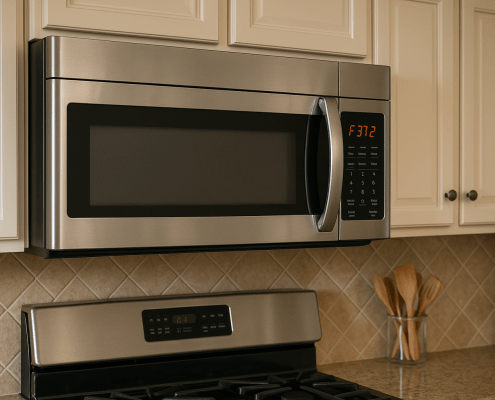E02 and E03 Bosch Washer Error Codes: A Troubleshooting Guide
Steven E / Tuesday May 13, 2025
Have you encountered an E02 or E03 error code on your Bosch front-load washer? The good news is that DIY troubleshooting can resolve these door lock errors quickly and get your Bosch washer working again. This detailed guide provides in-depth explanations for diagnosing and fixing an E02 and E03 Bosch washer error. We’ll review troubleshooting steps you can perform yourself to save on repair costs.
If you find out that you need any replacement parts for your appliance while you’re troubleshooting, you can enter your model number at AppliancePartsPros.com to order them. Most orders arrive in just two business days, and we have thousands of free guides to show you how to install your new parts.
The information in this article may not apply to your specific appliance model. We recommend consulting your manufacturer’s documentation or contact us with any questions.
What do the error codes mean?
These fault codes signify issues with the washer’s door-locking function that prevent normal operation. Specifically, E02 means the door fails to unlock at the end of the wash cycle, while E03 indicates it fails to lock at the cycle start.
To troubleshoot E02 and E03 faults, it helps to understand the parts that make up the door lock system:
- The door latch assembly interfaces with the door lock bolt to secure the door closed.
- When a wash cycle starts, the control module sends voltage signals to activate the door lock actuator. This rotates and engages the lock bolt.
- At the end of the wash, the control board reverses the voltage polarity going to the actuator to disengage the bolt and unlock the door.
- Door lock switches provide feedback signals to the control board on when the door is closed and in the fully locked position.
- The door seal forms a watertight gasket when the door is locked during wash fill and tumbling.
Safety precautions
When working on any appliance, remember to keep safety first. Here are some tips to keep in mind:
- Always power off and unplug your appliance or switch off the circuit breaker before attempting any maintenance or replacement work. This keeps you safe by preventing any risk of injury from electric shock.
- Wear insulated work gloves to protect your hands from sharp metal parts, pinching hazards and debris.
- Take your time and don’t rush while working to prevent accidents and personal injuries.
- Work in a well-lit area so you can clearly see and access the interior parts.
- Clear your workspace of clutter and other obstacles. Keep children and pets away from the work area.
- Never work on internal parts with bare wet hands. Make sure the work area is completely dry.
- Check your user manual to see if there are specific installation or safety instructions for your part or appliance.
- Be gentle when handling or removing parts. Excessive force might damage the appliance or cause injury.
- Wear safety glasses when working with chemicals, dust or cleaning large debris to prevent injury.
- If the appliance has recently been used, give it plenty of time for any heating parts to cool down before working on it.
- Take pictures or make a note of wiring terminals or other connections before disconnecting to prevent any problems with reassembly.
- When working with wires, avoid touching any exposed wires or terminals. If you need to touch a wire, use a non-conductive tool or wear insulating gloves to prevent electrical shock.
Troubleshooting steps for E02 error
When your Bosch washing machine displays fault code E02 at the end of the wash cycle, it means the door has failed to unlock as intended. Here is a detailed look at how to troubleshoot this problem:
Step 1: Test the door lock resistance
The door lock itself contains internal components that rotate to lock and unlock the door. Excessive resistance due to damage or wear can prevent proper rotation. Use a multimeter to check the lock’s electrical resistance as follows:
- Unplug the washer from the power supply for safety before testing. Locate and detach the door lock wire harness connector.
- Set your multimeter to Ohms (represented by the Ω symbol) and touch the meter probes to the connector terminals. Consult your Bosch washer’s service manual for the exact resistance spec, but typically it should fall between 159-211 ohms.
- Any reading outside this normal range means the door lock is faulty and must be replaced. The damaged lock cannot rotate appropriately to unlock the door.
Step 2: Inspect the door lock actuator linkage
The actuator is the electric motor that rotates the lock bolt into both the lock and unlock positions.
- Remove the washer’s front access panel to expose the door lock actuator mounted on the door frame rim.
- Observe the actuator linkage while manually toggling the lock. The linkage arm should move smoothly through its entire range of motion without binding.
- Look closely for any obstructions, bent parts, or damage to the linkage that could hinder operation. Make any necessary mechanical adjustments or replace damaged actuator parts.
Step 3: Check door lock switches
The door lock switches and wiring harness provide crucial electrical signaling between components.
- Unplug the washer and remove the door lock wire harness connectors. Inspect the connectors closely for any corroded pins or loose wire terminals.
- Check harness wiring for fraying, cuts, or shorts. Repair any wiring damage found.
- With your multimeter, check door lock switch continuities while actuating them manually. Replace any malfunctioning switches.
- Reinstall the harness connectors securely to ensure robust electrical connections. Eliminate any possibilities for intermittent contact or shorts.
Step 4: Replace the control board
If the door lock components all check out, the control board itself could be the culprit in the E02 failure to unlock.
- Unplug the washer for a minimum of 1 minute to completely drain power and reset the control board. This clears any signals.
- Run a test cycle after resetting to see if door operation is restored before replacing the control board unnecessarily.
- If the E02 persists, replace the faulty control board that is not properly sending the unlock activation signal. Only use an exact replacement part number specific for your Bosch washer model.
Troubleshooting steps for E03 error
When the E03 error code appears on your Bosch washer display, it indicates the door has failed to lock at the start of the wash cycle. Here is a detailed breakdown of troubleshooting steps:
Step 1: Check door latch alignment
- Manually disengage the door latch assembly and closely inspect where it interfaces with the lock bolt.
- Loosen mounting fasteners if needed to make adjustments to achieve perfect alignment with the bolt.
- Replace a visibly damaged or worn out latch that is preventing solid door closure when locked.
Step 2: Test door lock resistance
- Use a multimeter to check the electrical resistance of the door lock mechanism itself. Consult your model’s service manual, but normal is 159-211 ohms. Resistance outside this signals a faulty lock.
- Visually inspect the lock for debris, excessive wear, or broken parts that could impede function. Attempt to actuate the lock manually while observing.
Step 3: Inspect door lock switches and wiring
- Faulty switches and harness wires can fail to properly signal the locked status to the control board.
- Unplug the washer and check all door lock switches and wiring connections. Repair any shorts or damage.
- Actuate switches manually while testing continuity with a multimeter. Replace any malfunctioning lock switches.
Step 4: Check control board voltage
- Use a voltmeter to check for 120V present at the door lock harness when the control board sends the lock activation signal.
- No voltage indicates the control board is faulty. Replace it if operation is not restored after draining power to reset the control board.
Additional information
Thank you for reading! We hope you found this information useful to get your washer working again.
If you have any other appliance repair needs or projects, don’t hesitate to explore our thousands of free videos and troubleshooting guides available. If you need replacement parts or some extra help, grab your model number and head over to AppliancePartsPros.com, where you can chat with a pro, order parts, read our DIY blog, and more.
Be sure to subscribe to us on YouTube and follow us on Facebook, Twitter, and Instagram!
With nearly a decade of experience in providing top-notch customer service regarding appliance parts and repair, Steven enjoys sharing practical advice, troubleshooting tips, and interesting information to help readers stay informed.





